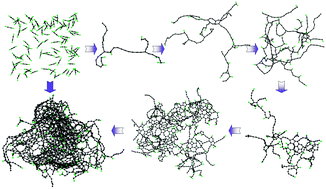Imaging the C black formation by acetylene pyrolysis with molecular reactive force field simulations†
Abstract
C black is a class of substantial materials with a long history of applications. However, apart from some descriptions of primary reactions, subsequent processes leading up to the final formation mechanism remain unclear. This mechanism is also crucial for understanding the formation of other carbonaceous materials. In this work, we visualize C black formation by acetylene pyrolysis using molecular dynamics simulations with a molecular reactive force field named ReaxFF. We find that the formation undergoes four stages: (1) chain elongation by H abstraction and polymerization of small C species, (2) chain branching, (3) cyclization and ring densification, and (4) condensed ring folding. The simulated C black particle possesses a structure of folded graphite layers, which is in good accordance with experimental observations. Cyclization and condensation are derived from fusion between neighboring chains, significantly varying from common experimental observations at relatively low temperatures that abide by the mechanism of H abstraction and C2H2 addition. Moreover, polyyne and polyene are usually found during acetylene pyrolysis, suggesting that the pyrolysis of acetylene and other hydrocarbons may be a feasible method of obtaining carbyne, a novel carbonaceous material with a high value.


 Please wait while we load your content...
Please wait while we load your content...